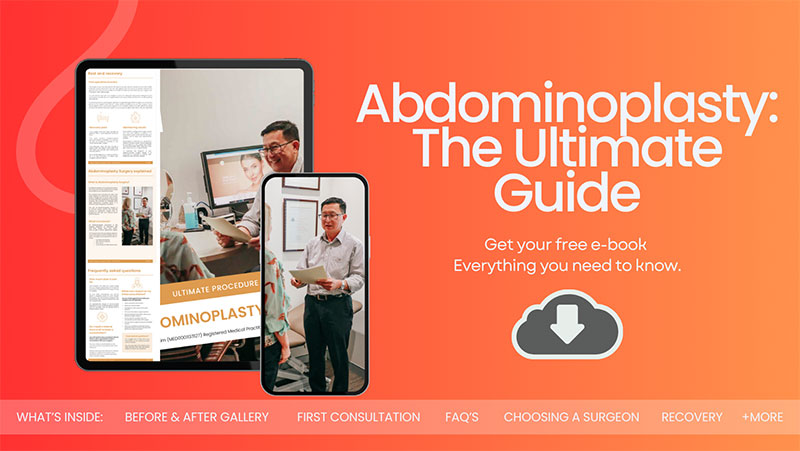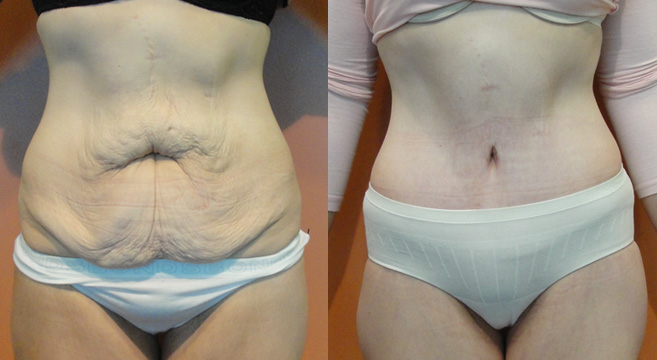What to Expect After Abdominoplasty Surgery
Abdominoplasty, also known as a tummy tuck, is a surgical procedure aimed at improving the appearance of the abdomen. This procedure involves removing excess skin and fat from the middle and lower abdomen and tightening the muscles of the abdominal wall. Abdominoplasty is often sought by individuals who have experienced significant weight loss, pregnancy, or simply struggle with stubborn abdominal rolls that are resistant to diet and exercise.
If you’re curious about whether abdominal rolls or folds will persist post-abdominoplasty, you can read more in this blog where Sydney Plastic Surgeon Dr Jake Lim elaborates on the intricacies of the procedure, shedding light on how abdominoplasty paves the way to an improved abdomen.
Dr Lim’s 2024 Abdominoplasty Guide

Reasons for Abdominal Rolls
Abdominal rolls, often perceived as an aesthetic concern, are prevalent among many individuals. The origins of these rolls can be traced back to many factors, painting a complex picture of how they came to be. Below is a more detailed exploration of the causes:
- Genetic Predisposition: One of the primary factors behind the formation of abdominal rolls is genetics. A person’s genetic makeup can predetermine the way their body stores fat, and for some, the abdominal region becomes a primary storage area. The propensity to develop abdominal rolls may be inherited from family members who share similar body types or fat distribution patterns.
- Pregnancy: Pregnancy significantly alters a woman’s body, and the abdomen is no exception. The stretching of the abdominal wall to accommodate a growing fetus can result in stretched skin and weakened or separated abdominal muscles, commonly known as diastasis recti. Post-pregnancy, some women may notice the formation of abdominal rolls due to the lingering excess skin and fat.
- Weight Fluctuations: Frequent weight gain and loss can cause the skin and underlying tissues in the abdominal area to stretch and contract repeatedly, eventually leading to the loss of skin elasticity. This loss of elasticity coupled with accumulated fat can manifest as stubborn abdominal rolls.
- Natural Ageing Process: As individuals age, the body’s metabolic rate slows down, and the distribution of fat can change. Concurrently, the skin loses its elasticity, and muscle tone diminishes. All these factors can contribute to the development of abdominal rolls over time.
How Abdominoplasty Surgery Can Help Achieve a Flatter Abdomen
Abdominoplasty surgery can help achieve a flatter abdomen by addressing multiple concerns. The procedure, as performed by Dr Jake Lim, entails an incision along the lower abdomen, which acts as a gateway to the tissues lying beneath. Here are more details about the procedure and benefits:
- Incision and Access: The procedure begins with an incision, a crucial step that Dr Lim performs with surgical precision. This incision, usually situated along the lower abdomen, grants access to the underlying tissues and muscles, setting the stage for the work that follows
- Removal of Excess Skin and Fat: The hallmark of abdominoplasty is the removal of excess skin and fat that often contribute to a protruding or saggy abdominal profile. By meticulously excising this surplus material, Dr Lim takes the first step towards flattening the abdomen
- Tightening of Abdominal Muscles: An often underappreciated aspect of a tummy tuck is the tightening of the abdominal wall muscles. Over time or due to specific life events like pregnancy, these muscles can become lax or separated—a condition known as diastasis recti. Abdominoplasty addresses this by suturing the muscles closer together and reinstating the natural corset of the abdomen which further contributes to a flatter, firmer abdominal profile
- Achieving Aesthetic Balance: By addressing the contours and symmetry, Dr Lim aids in achieving a more balanced and proportionate appearance
- Personalised Approach: Every patient is different, and every abdominoplasty is a tailored journey. Dr Lim’s approach ensures that the specific concerns and anatomical uniqueness of each patient are acknowledged and addressed, delivering a personalised and satisfying outcome

Preparing for Abdominoplasty Surgery
Before undergoing abdominoplasty surgery, it is important to properly prepare yourself both physically and mentally. Dr Lim will provide you with specific instructions to follow in the weeks leading up to the procedure. These instructions may include quitting smoking, adjusting any medications, and maintaining a healthy lifestyle.
It is also essential to have a thorough consultation with Dr Lim. During this consultation, he will evaluate your medical history, examine your abdomen, and discuss your goals and expectations. He will explain the procedure in detail and answer any questions or concerns you may have. It is important to be open and honest about your expectations to ensure the best possible outcome.
Recovery and Healing After Abdominoplasty Surgery
After abdominoplasty surgery, it is crucial to allow your body time to heal and recover. The initial recovery period can vary from person to person, but most individuals can expect some discomfort, swelling, and bruising. Dr Jake Lim will provide you with specific post-operative care instructions to follow.
It is important to take any prescribed pain medications as directed and to avoid any activities that may strain your abdominal muscles. Getting plenty of rest and maintaining a healthy diet can also aid in the healing process. It is essential to attend all follow-up appointments with Dr Jake so he can monitor your progress and address any concerns.
During the recovery period, it is common to experience some emotional ups and downs. It is important to be patient with yourself and to reach out for support if needed. Remember that the final results of your abdominoplasty surgery may take several months to a year to fully manifest, so it is crucial to be patient and allow your body to heal at its own pace.
What to Expect after Abdominoplasty Surgery
After undergoing abdominoplasty surgery, it is important to have realistic expectations regarding the results. While the procedure can provide significant improvements in the appearance of the abdomen, it is essential to understand that the final outcome may take time.
Initially, you may experience some swelling and bruising, which can obscure the final results. It is important to be patient and allow your body time to heal. Over the course of several weeks and months, the swelling will gradually subside, revealing a flatter and more sculpted abdomen.
It is also important to maintain a healthy lifestyle after abdominoplasty surgery to optimise and prolong the results. This includes regular exercise, a balanced diet, and avoiding weight fluctuations.
Maintaining a Flatter and More Sculpted Abdomen after Abdominoplasty
To maintain a good result after abdominoplasty surgery, it is important to adopt healthy habits. Regular exercise, particularly core-strengthening exercises, can help maintain muscle tone and prevent the accumulation of excess fat. A balanced diet rich in fruits, vegetables, and lean proteins is also crucial for optimal health and weight management.
It is important to avoid smoking and excessive alcohol consumption, as these habits can negatively impact your overall health and the longevity of your results. Additionally, staying hydrated and practicing good skincare can help keep your skin looking its best.
Regular follow-up appointments with your plastic surgeon are also essential to monitor your progress and address any concerns. Dr Lim can provide guidance on maintaining your results and recommend any additional treatments or procedures that may be beneficial.
FAQs about Abdominoplasty Surgery

What is abdominoplasty surgery?
- Abdominoplasty, commonly known as a tummy tuck, is a surgical procedure aimed at improving the stomach area by removing excess skin and fat, and in some cases, repairing separated abdominal muscles. This procedure is typically pursued by individuals who have loose or sagging skin following significant weight loss or pregnancy.
Who is a good candidate for abdominoplasty?
- Good candidates are individuals who have recently lost a lot of weight or have loose skin hanging over their pubic area, which can cause problems with hygiene and clothing fit. It’s not a substitute for weight loss through diet and exercise.
Does insurance cover abdominoplasty?
- Tummy tucks – abdominoplasties are generally considered out-of-pocket procedures as most insurance providers won’t cover the costs, although it’s advisable to check with your insurance provider since circumstances can vary. In some cases, Medicare can cover you abdominoplasty, if the procedure is medically necessary.
What are the different abdominoplasty procedures?
- There are two main types: a full and a mini abdominoplasty. The mini version entails a slightly smaller incision to get rid of excess skin however does not address the muscle separation, generally being a shorter procedure compared to a full abdominoplasty. This often translates to faster recovery periods.
What risks are involved with abdominoplasty?
- Like all surgical procedures, abdominoplasty comes with certain risks including adverse reactions to anaesthesia, infection, and bleeding. A thorough discussion with Dr Lim regarding these and other potential risks is imperative if you’re contemplating this surgery.
What is the recovery time for abdominoplasty?
- Recovery duration can fluctuate, but on average, it might take up to 8 weeks for individuals to start feeling like their usual selves post-surgery. Your plastic surgeon will provide a more tailored recovery timeline based on your physique and the complexity of the procedure.
How long does the abdominoplasty procedure last?
- The length of the surgery hinges on the specific type chosen. Typically, these operations can span between 2 to 4 hours, with the possibility of an overnight hospital stay being recommended.
Further Reading about Abdominoplasty Surgery with Dr Jake Lim
- Read Dr Jake Lim’s Blog about Medicare Cover for Abdominoplasty Surgery in Sydney
- Read Dr Jake Lim’s Blog about 5 Methods to Reduce Your Abdominoplasty Scars
- Read Dr Jake Lim’s Blog about What Do the Scars Look Like after Abdominoplasty
- Read Dr Jake Lim’s Blog about 7 Things You Need to Know about Pregnancy after Abdominoplasty
- Read Dr Jake Lim’s Blog about Split Muscles after Pregnancy – Diastasis Recti
- Read Dr Jake Lim’s Blog about Recovery after Tummy Tuck – Abdominoplasty
- Read Dr Jake Lim’s Blog about Different Types of Belly Fat and How To Get Rid Of It
- Read Dr Jake Lim’s Blog about Excess Skin Removal: What are ‘Dog Ears”
- Read Dr Jake Lim’s Blog about How your BMI impacts Abdominoplasty Results
- Read Dr Jake Lim’s Blog about How to get rid of FUPA – Fat Upper Pubic Area
Medical References about Abdominoplasty
- Tummy tuck – Mayo Clinic
- Aesthetic and Functional Abdominoplasty
- Abdominoplasty (Tummy Tuck): Risks, Recovery – Cleveland Clinic




